Curated Playlist: Controversial Youth Television in the Netherlands
By Grietje Hoogland (University of Amsterdam)
In a country with an ideologically segmented society, television was bound to spark some controversy every now and then. Dutch society was roughly divided in four main ‘pillars’: a catholic, protestant, socialist and liberal group in society that from the late 1910s until the mid 1960s had their own political parties, associations, newspapers and broadcasting associations.[1] With the start of television in 1951, these pillarised broadcasting associations had to divide the airing time, first on one channel, from 1964 on two channels and from 1988 on three.
For youth television, all broadcasting associations had a similar approach: the general conviction was that children are impressionable, and therefore Dutch children’s television started with very safe and educational content. As a starting point for exploring the large topic of entertaining youth programming, this curated playlist offers a selection of some of the programs that were perceived as controversial by the media, parents of the children watching, political parties or broadcasting associations themselves because they were deemed too violent, sexually explicit, blasphemous, insensitive to racial issues, sexist or other. This playlist is deliberately randomised in terms of category and chronology, to prevent a false sense of one category or decade dominating in controversial youth television.
Below every program image the ResourceID is mentioned: with this ResourceID you can find that particular episode in the Clariah Media Suite.
1. Woord voor Woord (IKOR, 1965-1976)
The biblical television program Woord voor Woord (Word for Word) for children from 6 to 10 years old, was made and broadcast by Catholic broadcasting association IKOR. In this program, presenter Aart Staartjes narrated stories from the Bible in language that young children would use themselves. This resulted in angry letters from parents stating that Staartjes is a “left wing ‘nozem’ (hippie) from Amsterdam”, who tried to popularise something that in their view should be treated with more respect.[2] Nevertheless, children responded so well to the clear explanations that Woord voor Woord aired for 11 years, and a children’s Bible with the same title was written based on the television program.
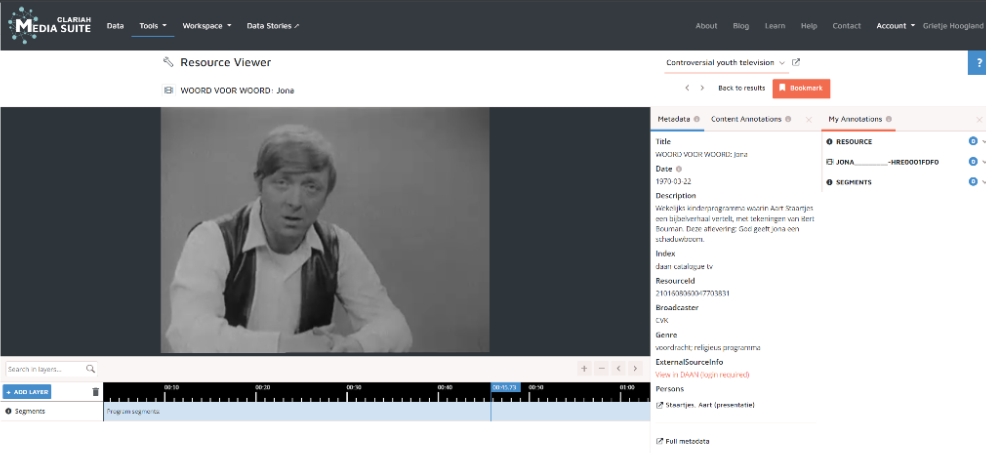
ResourceID: 2101608060047703831, Link to video (login required)
2. Open en bloot (VARA, 1974)
A program made for the older teens and young adults, Open en bloot (Open and nude / exposed) was the first television program on sexual education on Dutch television. The first episode was watched 5.5 million times, with a national viewing density of 51%, 45% among 15-19 year olds, 58% among 20-24 year olds and among 25-34 year olds even 60%.[3] The program aimed to provide serious and complete information on various topics surrounding sexuality, such as STD’s, masturbation and contraception, alternated with sketches and interviews with young adults. Since the most important aim was to reach older teens and young adults who started working right after highschool, the program used normal, day to day language that the youth used as well. This was to assure that the message would come across, as well as to normalise having conversations about these topics. Presenter Joop van Tijn was the first to use the F-word on national television, which was a big issue for the viewers who took the time to write to the program.[4]
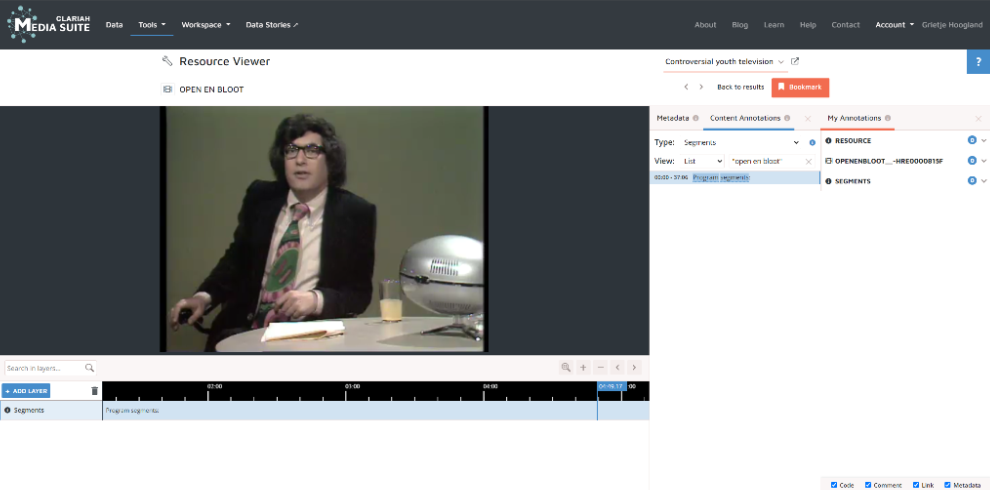
ResourceID: 2101608060043578131, Link to video (login required)
3. Purno de Purno (VPRO, 1989-2007)
Purno de Purno is a computer animated series made by Marcus Vlaar and Hans Wessels for the progressive VPRO. A little man called Purno in a purple ice skating suit goes on adventures, encountering a wide variety of imaginative things that involve visual sexual jokes. The program was highly popular with children just reaching puberty, but the program received many letters from angry parents stating that younger children are watching too. It would be too damaging to them. The makers are not concerned about that, stating that violence has a bigger impression on smaller kids than sex, since sex jokes just go over their heads.[5]
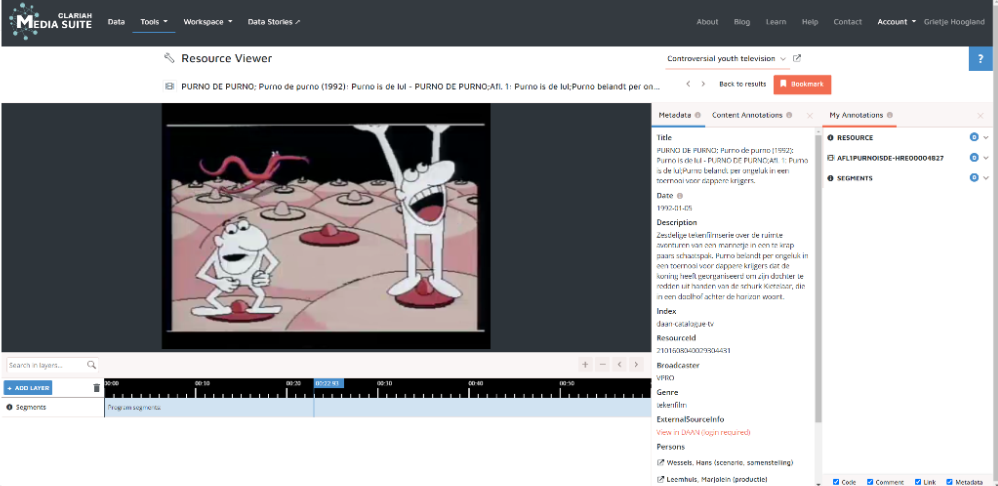
ResourceID: 2101608040029304431, Link to video (login required)
4. Vjoew (AVRO, 1966-1968)
Between 1966 and 1968, the liberal AVRO programmed Vjoew, a program for older teens and young adults interested in, and critical of the world around them. The program shows a mixture of serious topics, pop music and satire on politics, society and religion, presented by young people. A couple of episodes have been cancelled right before the broadcast and replaced by something else, because after seeing the tape the broadcaster deemed the content too controversial.[6] It is unclear which items caused the episodes to be cancelled.

ResourceID: 2101608060042993331, Link to video (login required)
5. Dokter Corrie (STV, 2013)
Sexual education on national television will always be uncomfortable for some parents. In the case of Dokter Corrie, who takes a fun and humoristic, but well informed approach, around 8000 parents signed a protest letter to take the program off the television screen because they found the program to be vulgar. Secretary of State Dekker simply stated that if you don’t like the program, you should not watch it.[7]
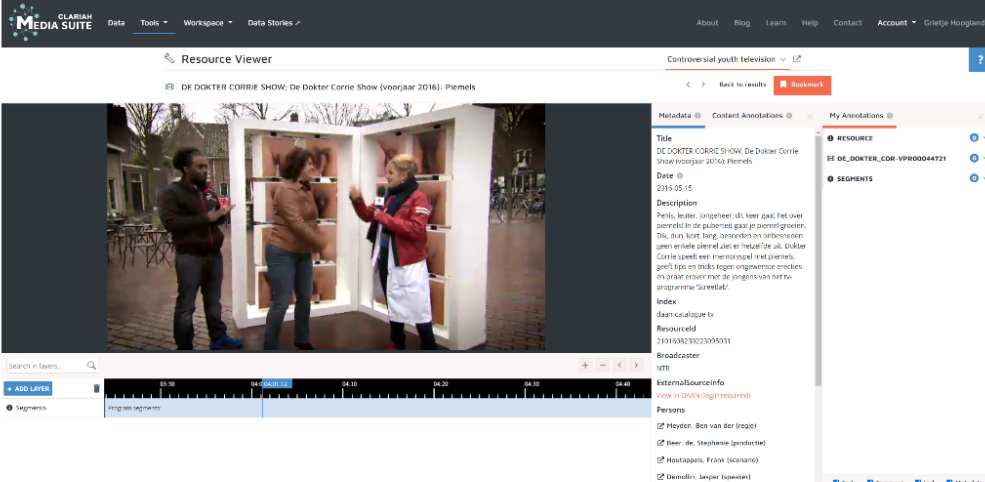
ResourceID: 2101608230223095031, Link to video (login required)
6. Stratemakeropzeeshow (VARA, 1972-1974)
A fun and playful program for the smaller children, with sketches in which the children are the experts and parents are childish, alternated with songs and interviews with children. Stratemakeropzeeshow was highly popular, but because of the naugty content of some items, not all parents appreciated the program. Children were asked the question: “What is sex?”, and sketches contained jokes about poop or genitals. Parents accused the program of teaching children foul language.[8]

ResourceID: 2101608040029584631, Link to video (login required)
7. De film van ome Willem (VARA, 1974-1989)
A similarly lighthearted program was De film van ome Willem. In this program with children in the studio, ome Willem, played by Edwin Rutten, was criticised by some parents because he asked children in the opening song if they would like a poop sandwich. But a larger point of criticism was that in the same opening song, Rutten asks if there are girls in the room while making a hand gesture of a dress, and if there are boys in the room showing muscles, thereby pushing children into stereotypical gender roles.[9]
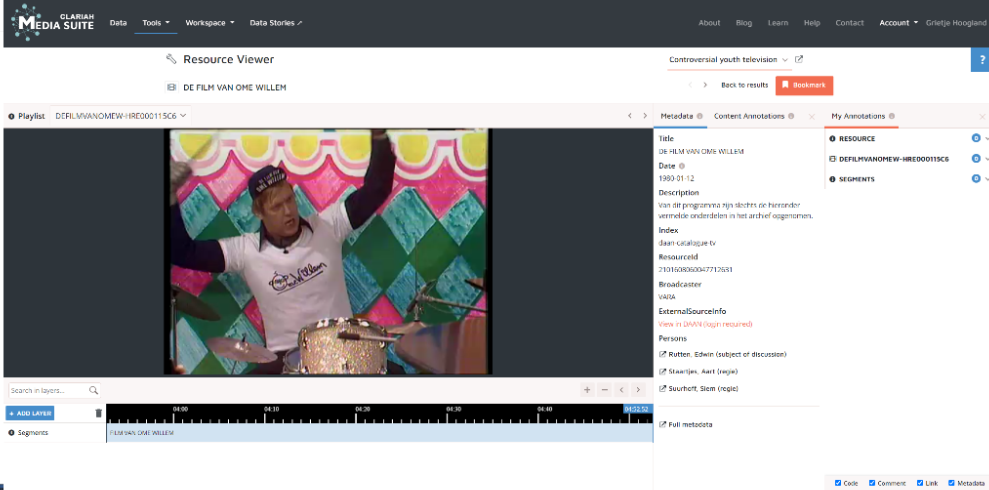
ResourceID: 2101608060047712631, Link to video (login required)
8. Hoepla (VPRO, 1967)
A very famous example of a controversial youth program is Hoepla, a program that aimed to showcase the underground culture and break with taboos. Several topics made the broadcaster decide that this program was too controversial for the Dutch audience of 1967, one of which was the scene in which photo model Phil Bloom read the newspaper nude, after which she folded up the paper and handed it over to the man next to her. This scene in the second episode was scratched before the broadcast, and after the third episode the program was cancelled in its entirety. Hoepla raised a parliamentary discussion on televised nudity, and although the scene was not broadcast, the short lived program and the nude Phil Bloom became very well known.[10]
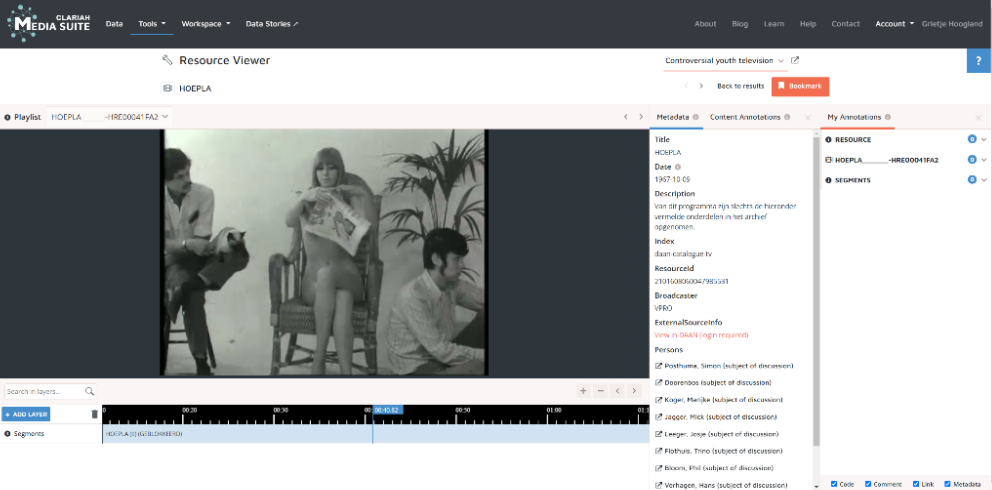
ResourceID: 2101608060047985531, Link to video (login required)
9. Onwijs (EO, 1994)
In the program Onwijs, by evangelical broadcasting association EO, young people with certain prejudices were dropped in a certain situation that challenges these prejudices. Especially the 9th episode, entitled Rijk (Rich), was controversial: three students were offered a trip to the Philippines, and after three days of being a tourist they were dropped on a dump to live as poor children do. One of the students left the program. Dutch program directors called the program ‘social pornography’ and stated that the program ‘asked too much of the children’. But at the Dutch youth film festival Cinikid, the program received a prize for children’s television, stating that the program gives a good insight into how children in other cultures live.[11]
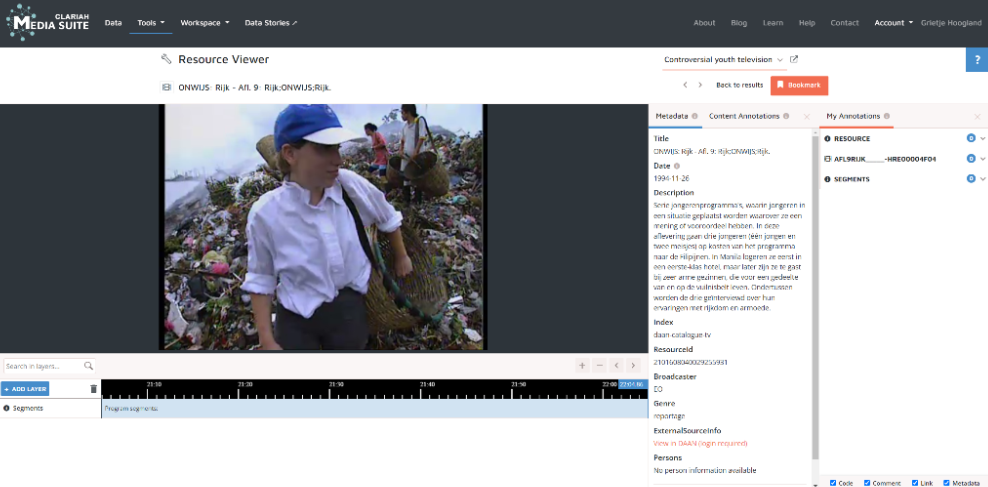
ResourceID: 2101608040029255931, Link to video (login required)
10. Theo & Thea (VPRO, 1985-1988)
Theo and Thea, two characters with wigs, headscarves and rabbit teeth played by Arjan Ederveen and Tosca Niterink, first appear as an item in Bij Nieuwegein rechtsaf, the predecessor of Villa Achterwerk. Their sketches are over the top and satirical, and often deal with sexuality. Parents are shocked by the blunt way in which the sketches are executed.[12]

ResourceID: 2101608050038879231, Link to video (login required)
11. Rembo & Rembo (VPRO, 1987-1994)
Similarly controversial and airing around the same time at the same broadcasting association is Rembo & Rembo. Played by Maxim Hartman and Theo Wesselo, Rembo and Rembo and many other characters among which Professor Paardekut (Professor Horsecunt) appear in sketches that are absurdistically rude. It goes without saying that not every parent was amused. They called the youth department of the VPRO to complain, and stated that their children were not allowed to look at it. Still the group that liked the program was large enough to broadcast the program for seven years.[13]

ResourceID: 2101608040029684731, Link to video (login required)
12. SpangaS (Z@PP, 2020)
The dramaseries SpangaS has always covered relevant topics that some children in school might deal with, from unrequited love to being gay and even deportation of a refugee classmate. In 2020, the series changed from a school setting to a campus, with many new characters, among whom Lesley, the first non-binary person in a Dutch television series. Although applauded by many, the news also sparked a lot of negative responses of people who believe there are ‘only two genders’, or that Lesley as well as Thorn Roos de Vries who plays the character and is non-binary themself, are ‘just confused’.[14]
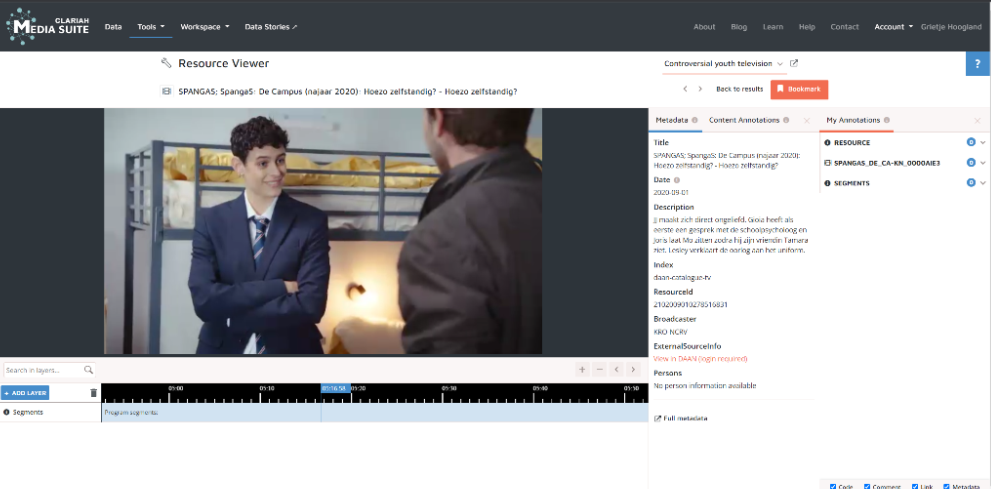
ResourceID: 2102009010278516831, Link to video (login required)
13. Sinterklaasjournaal (NTR, 2001-)
Since 2012, a large national debate has been going on about Zwarte Piet (Black Pete): about racism and how to change a beloved national tradition. Sinterklaas and his ‘helpers’, traditionally with black painted faces, come to the Netherlands every year in November and December and bring presents for all children. The debate on racism is taking place on all possible levels and platforms, but since the start of this debate, people are watching the Sinterklaasjournaal with intent. This television program for children shows in a fictional news setting how Sinterklaas and the pieten are preparing and delivering the presents, with fun storylines about things that go wrong and need to be resolved. The NTR as a public broadcasting association understands its role in society and tries to come up with changes to Zwarte Piet that are more inclusive, starting with petes in all colours and then moving towards petes with soot stains on their faces from climbing through chimneys. Every new development in the Sinterklaasjournaal is widely discussed in the media with people who are pro or against this development, but their decisions are slowly being introduced in local Sinterklaas celebrations as well.
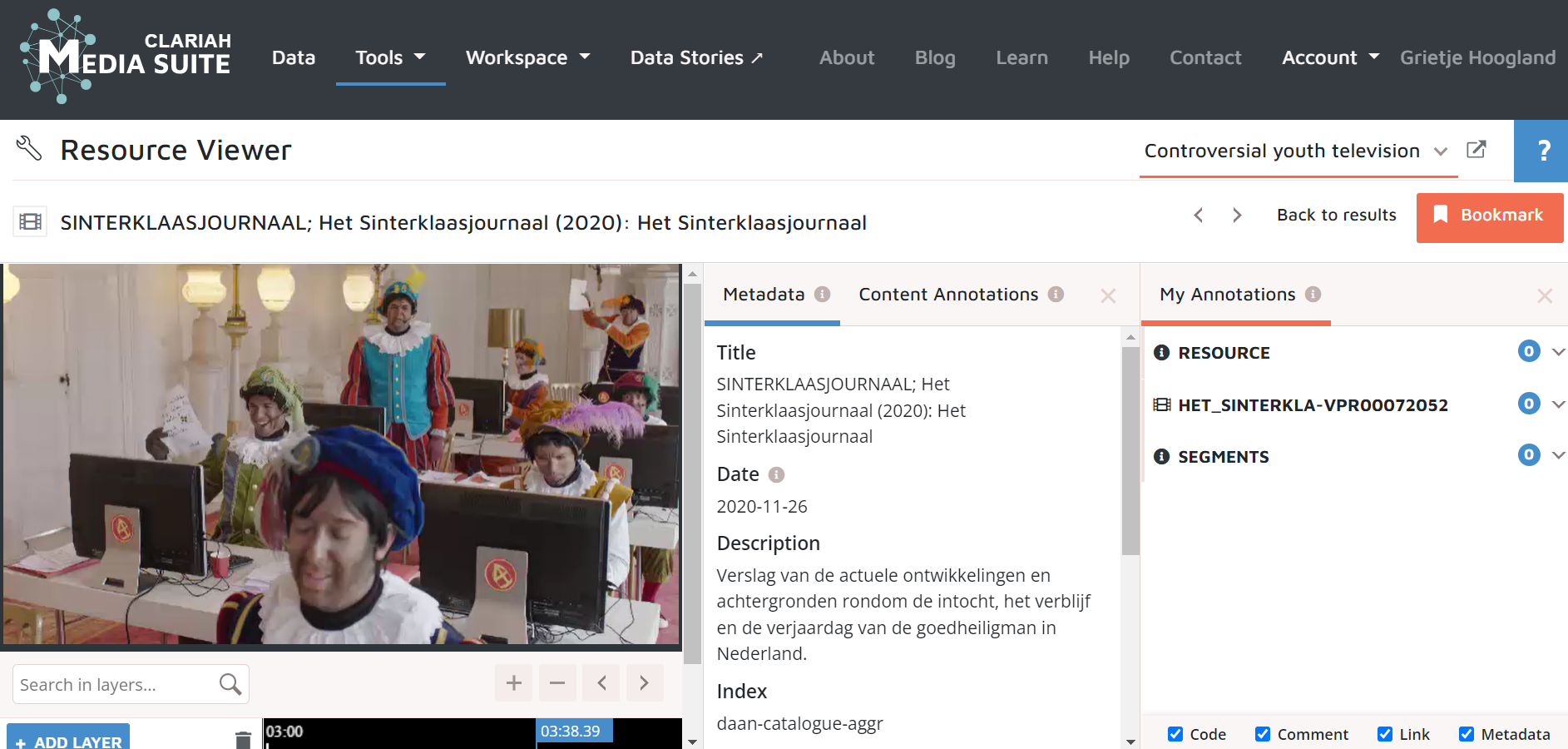
ResourceID: 2102011260287945731, Link to video (login required)
14. Toppop (AVRO, 1984): clip Golden Earring 1984
AVRO’s Toppop was a pop music program that ran from 1970 to 1988, modelled after Top of the Pops (BBC). The first years artists from over the world were invited into the studio to perform their songs, later music videos were broadcast. The band Golden Earring has had several performances in Toppop, but with the music video for When the Lady Smiles in 1984, some controversy rose. In the video, directed by Dick Maas, a nun is harassed on the subway by singer Barry Hay, after which he is publicly condemned by everyone on the subway, and a psychiatrist gives him his business card. After broadcasting it twice in other programs, the AVRO decided they did not want to broadcast this in youth program Toppop and asked Maas to change it, which he did, but according to Maas, the AVRO changed some other shots in the video as well.[15] This debate was reported on in several newspapers, and readers were asked how they thought about violence in video clips. According to readers of Het vrije volk they can handle violence in this clip and others, considering they also watched violent television series.[16]

ResourceID: 2101608040029615231, Link to video (login required)
15. Gewoon. Bloot. (Z@PP, 2021)
The Clariah Media Suite is a large, but not complete database. Even with very recent programs it is possible that they cannot be found in the database. Therefore it is always advisable to search outside the environment of the CLARIAH Media Suite as well.
Gewoon. Bloot. Is such a program, which is made in 2021 but is not found in the CLARIAH Media Suite. Gewoon. Bloot. (Just. Naked.) is a program in which children can ask naked adults questions about their bodies and everything else. The aim is to show real humans with real bodies, to counterweight all the edited content that is found online. Parents and the conservative political parties beforehand were angry because showing naked adults to children would be child-pornography, but after the first episode the tone in the media was much more moderate: it turned out not to be such a big deal after all. The questions that the children came up with were very child appropriate, and the conversations were civil and interesting.
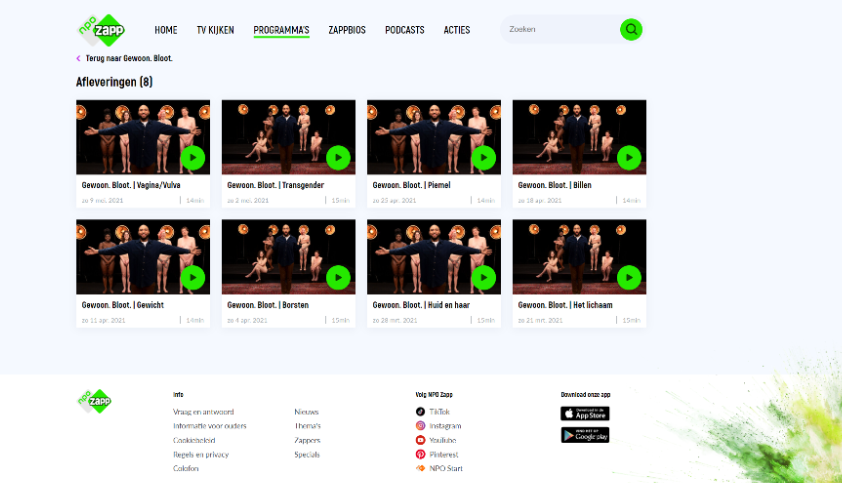
Further search suggestions
For this playlist I searched in the Sound and Vision television collection in the CLARIAH Media Suite, and in Delpher, and I mainly used search terms such as ‘kinderprogramma’, ‘jeugdprogramma’ and ‘jongerenprogramma’ in combination with ‘ophef’, ‘controverse’, etc. to connect the outrage in the media to the programs themselves. I also relied on a couple of programs that are already widely known for their controversy, in oral history as well as literature. Further research suggestions could be to continue on one category (sex, racism, violence etc) and continue searching in this more specific direction. It might also be interesting to look at other media such as radio or film.
Footnotes
[1] Christopher G. A. Bryant, “Depillarisation in the Netherlands”, The British Journal of Sociology , Vol. 32, No. 1, 1981, 56-74
[2] De Volkskrant,* De Ark van Noë in de haven*, 17-08-1968, 29
[3] Het vrije volk, Open en bloot Nr. 1 boekte vele records , 21-2-1974, 19
[4] Algemeen Dagblad, “Seks toch nog een taboe in Nederland”: Open en bloot is een succes , 16-5-1974, 23
[5] Vice.nl, Sinds augustus staat Purno de Purno op YouTube achter een 18+-muur , 23-12-2013
[6] Algemeen Dagblad, Boomkens: “Er is meer dan prestatie leveren” , 30-7-1982; Algemeen Dagblad, Tv-taboes in discussie: jonge programmamakers en kritisch publiek , 1-2-1968; Leidsch Dagblad, Hilversumse censuur door de jaren heen , 24 januari 1976, 5
[7] Jeugdjournaal, 19-11-2013
[8] De eerste keer: kinderprogramma’s , VPRO, 13-10-2012; Het Parool, Na tumult respect , 12-12-1972, 17
[9] Algemeen Dagblad, Ome Willem jubileert , 25-3-1989
[10] Limburgsch dagblad, Geen bloot in tv-uitzending Hoepla , 30-9-1967; Nieuwsblad van het Noorden, Reacties op Hoepla-bloot vallen mee , 16-10-1967
[11] Trouw, Omstreden jeugdprogramma ‘Onwijs’ krijgt prijs van Unicef , 23-10-1995, 3
[12] Het vrije volk, Zaterdagochtend-jeugd-tv bij de VPRO: “Dat heb ik afgezet. Maar m’n kind was wel boos”, 06-10-1987, 2
[13] Het vrije volk, Zaterdagochtend-jeugd-tv bij de VPRO: “Dat heb ik afgezet. Maar m’n kind was wel boos”, 06-10-1987, 2
[14] NOS.nl, Na kritiek op non-binair personage SpangaS is er nog een lange weg te gaan , 31-8-2020; NOS Stories op Instagram, 29-8-2020
[15] Het vrije volk,* Earringfilmpje gekuist*, 3-2-1984; Het Parool, Kwaadheid over knippen in clip , 4-2-1984, p10
[16] Het vrije volk, *De aangerande non van Golden Earring, *16-2-1984, 13
References
-
Algemeen Dagblad, “Seks toch nog een taboe in Nederland”: Open en bloot is een succes, 16-5-1974, 23
-
Algemeen Dagblad, Boomkens: “Er is meer dan prestatie leveren”, 30-7-1982
-
Algemeen Dagblad, Ome Willem jubileert, 25-3-1989
-
Algemeen Dagblad, Tv-taboes in discussie: jonge programmamakers en kritisch publiek, 1-2-1968; Bryant, Christopher G. A.m, “Depillarisation in the Netherlands”, The British Journal of Sociology, Vol. 32, No. 1, 1981, 56-74
-
De eerste keer: kinderprogramma’s, VPRO, 13-10-2012
-
Jeugdjournaal, 19-11-2013
-
Leidsch Dagblad, Hilversumse censuur door de jaren heen, 24 januari 1976, 5, https://leiden.courant.nu/issue/LD/1976-01-24/edition/0/page/5https://www.vice.com/nl/article/znp5m3/kinderserie-purno-de-purno-staat-sinds-kort-op-youtube-achter-een-18-muur
-
Limburgsch dagblad, Geen bloot in tv-uitzending Hoepla, 30-9-1967
-
Metro Nieuws, Ophef over tv-programma met naakte mensen en kinderen: ‘Walgelijk’, 6-3-2021, https://www.metronieuws.nl/televisie/2021/03/ophef-over-gewoon-bloot/
-
Nieuwsblad van het Noorden, Reacties op Hoepla-bloot vallen mee, 16-10-1967
-
NOS.nl, Na kritiek op non-binair personage SpangaS is er nog een lange weg te gaan, 31-8-2020, https://nos.nl/artikel/2346167-na-kritiek-op-non-binair-personage-spangas-er-is-nog-een-lange-weg-te-gaan
-
NOS Stories op Instagram, 29-8-2020, https://www.instagram.com/p/CEefDF4B_t_/?utm_source=ig_embed
-
Het Parool, Kwaadheid over knippen in clip, 4-2-1984, p10
-
Het Parool, Na tumult respect, 12-12-1972, 17
-
Trouw, Omstreden jeugdprogramma ‘Onwijs’ krijgt prijs van Unicef, 23-10-1995, 3
-
Vice.nl, Sinds augustus staat Purno de Purno op YouTube achter een 18+-muur, 23-12-2013, https://www.vice.com/nl/article/znp5m3/kinderserie-purno-de-purno-staat-sinds-kort-op-youtube-achter-een-18-muur
-
De Volkskrant, De Ark van Noë in de haven, 17-08-1968, 29
-
Het vrije volk, De aangerande non van Golden Earring, 16-2-1984, 13
-
Het vrije volk, Earringfilmpje gekuist, 3-2-1984
-
Het vrije volk, Open en bloot Nr. 1 boekte vele records, 21-2-1974, 19
-
Het vrije volk, Zaterdagochtend-jeugd-tv bij de VPRO: “Dat heb ik afgezet. Maar m’n kind was wel boos”, 06-10-1987, 2 Wijfjes, H.B.M., De televisie: Een cultuurgeschiedenis, Boom, 2021, 295-296